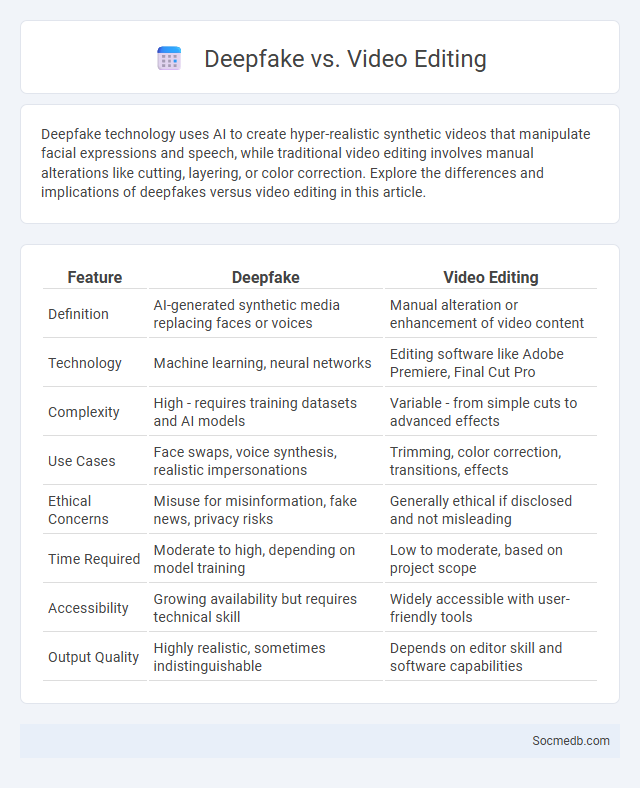
Photo illustration: Deepfake vs Video Editing
Deepfake technology uses AI to create hyper-realistic synthetic videos that manipulate facial expressions and speech, while traditional video editing involves manual alterations like cutting, layering, or color correction. Explore the differences and implications of deepfakes versus video editing in this article.
Table of Comparison
| Feature | Deepfake | Video Editing |
|---|---|---|
| Definition | AI-generated synthetic media replacing faces or voices | Manual alteration or enhancement of video content |
| Technology | Machine learning, neural networks | Editing software like Adobe Premiere, Final Cut Pro |
| Complexity | High - requires training datasets and AI models | Variable - from simple cuts to advanced effects |
| Use Cases | Face swaps, voice synthesis, realistic impersonations | Trimming, color correction, transitions, effects |
| Ethical Concerns | Misuse for misinformation, fake news, privacy risks | Generally ethical if disclosed and not misleading |
| Time Required | Moderate to high, depending on model training | Low to moderate, based on project scope |
| Accessibility | Growing availability but requires technical skill | Widely accessible with user-friendly tools |
| Output Quality | Highly realistic, sometimes indistinguishable | Depends on editor skill and software capabilities |
Introduction to Deepfake and Video Editing
Deepfake technology uses advanced artificial intelligence and machine learning algorithms to create highly realistic but synthetic videos by swapping faces or altering facial expressions and movements in social media content. Video editing tools equipped with deepfake capabilities enable creators to manipulate visual elements, enhancing content authenticity or generating entirely new digital personas for marketing and entertainment purposes. Understanding the ethical implications and detection techniques is crucial for navigating deepfake usage on social media platforms.
What is Deepfake Technology?
Deepfake technology uses advanced artificial intelligence algorithms to create hyper-realistic fake videos or audio by manipulating existing media. It employs neural networks, particularly generative adversarial networks (GANs), to superimpose faces or voices, making it difficult to distinguish between real and fabricated content. Social media platforms face significant challenges detecting and managing deepfakes, as these synthetic media can spread misinformation, influence public opinion, and damage reputations quickly.
Understanding Traditional Video Editing
Traditional video editing involves cutting, arranging, and enhancing raw footage to create a coherent narrative or message, a process crucial for producing professional-quality content for social media platforms. Editors use techniques such as trimming, color correction, audio synchronization, and adding visual effects to ensure videos capture audience attention and convey the intended story effectively. Mastering these foundational skills allows content creators to produce engaging videos that meet platform-specific requirements and drive higher engagement rates.
Key Differences Between Deepfake and Video Editing
Deepfake technology uses artificial intelligence and machine learning to create hyper-realistic synthetic videos by swapping faces or altering voices, often making it difficult to distinguish between genuine and manipulated content. Video editing involves traditional techniques like cutting, splicing, color correction, and adding effects to improve or alter existing footage without fundamentally changing a person's identity or speech. Understanding these key differences helps you recognize the authenticity of videos on social media and protect yourself from misinformation or digital manipulation.
How Deepfake Works: Tools and Techniques
Deepfake technology relies on advanced machine learning algorithms such as Generative Adversarial Networks (GANs) to create hyper-realistic synthetic media by swapping or manipulating facial features in videos and images. Key tools include deep neural networks that analyze and replicate facial expressions, voice patterns, and movements to produce convincing fake content. By training on large datasets, these techniques enable seamless blending of original and altered elements, posing significant challenges for social media platforms in detecting and mitigating deepfake misinformation.
Video Editing Methods: Software and Skills
Mastering video editing methods involves choosing the right software tailored to your social media goals, such as Adobe Premiere Pro for advanced features or InShot for mobile-friendly editing. Your skills should include cutting techniques, color correction, and adding engaging transitions to captivate your audience. Efficient use of these tools enhances your content's visual appeal, boosting engagement and reach across platforms.
Deepfake Applications in Media and Entertainment
Deepfake technology in media and entertainment revolutionizes content creation by enabling hyper-realistic video and audio manipulation, allowing filmmakers to de-age actors or resurrect iconic personalities seamlessly. This innovation enhances visual effects efficiency and opens new avenues for immersive storytelling while raising ethical questions about authenticity and misinformation. Platforms increasingly deploy AI-driven detection systems to combat misuse and maintain audience trust in digital content authenticity.
Ethical Concerns: Deepfake vs Video Editing
Deepfake technology poses significant ethical challenges by enabling the creation of hyper-realistic yet fabricated videos that can spread misinformation, manipulate public opinion, and violate individual privacy. Unlike traditional video editing, which involves altering footage for clarity or artistic purposes, deepfakes are designed to deceive viewers by seamlessly replacing faces or voices in digital content. The rise of deepfakes demands robust detection tools and regulatory frameworks to prevent misuse and protect the authenticity of information on social media platforms.
Detecting Deepfakes and Edited Videos
Detecting deepfakes and edited videos on social media relies heavily on advanced AI algorithms that analyze inconsistencies in facial expressions, lighting, and audio synchronization. Machine learning models trained on vast datasets can identify subtle artifacts and anomalies invisible to the human eye, improving the accuracy of deepfake detection tools. Continuous updates to detection frameworks are essential to keep pace with evolving manipulation techniques and protect users from misinformation.
The Future of Deepfake and Video Editing Technologies
Advancements in deepfake and video editing technologies are reshaping the social media landscape by enabling hyper-realistic content creation, raising concerns about authenticity and misinformation. AI-driven tools allow users to seamlessly alter videos, making it essential for your digital literacy to evolve alongside these innovations to discern genuine content. Continuous improvements in detection algorithms are critical to maintaining trust and ensuring the responsible use of deepfake media in social networks.
 socmedb.com
socmedb.com